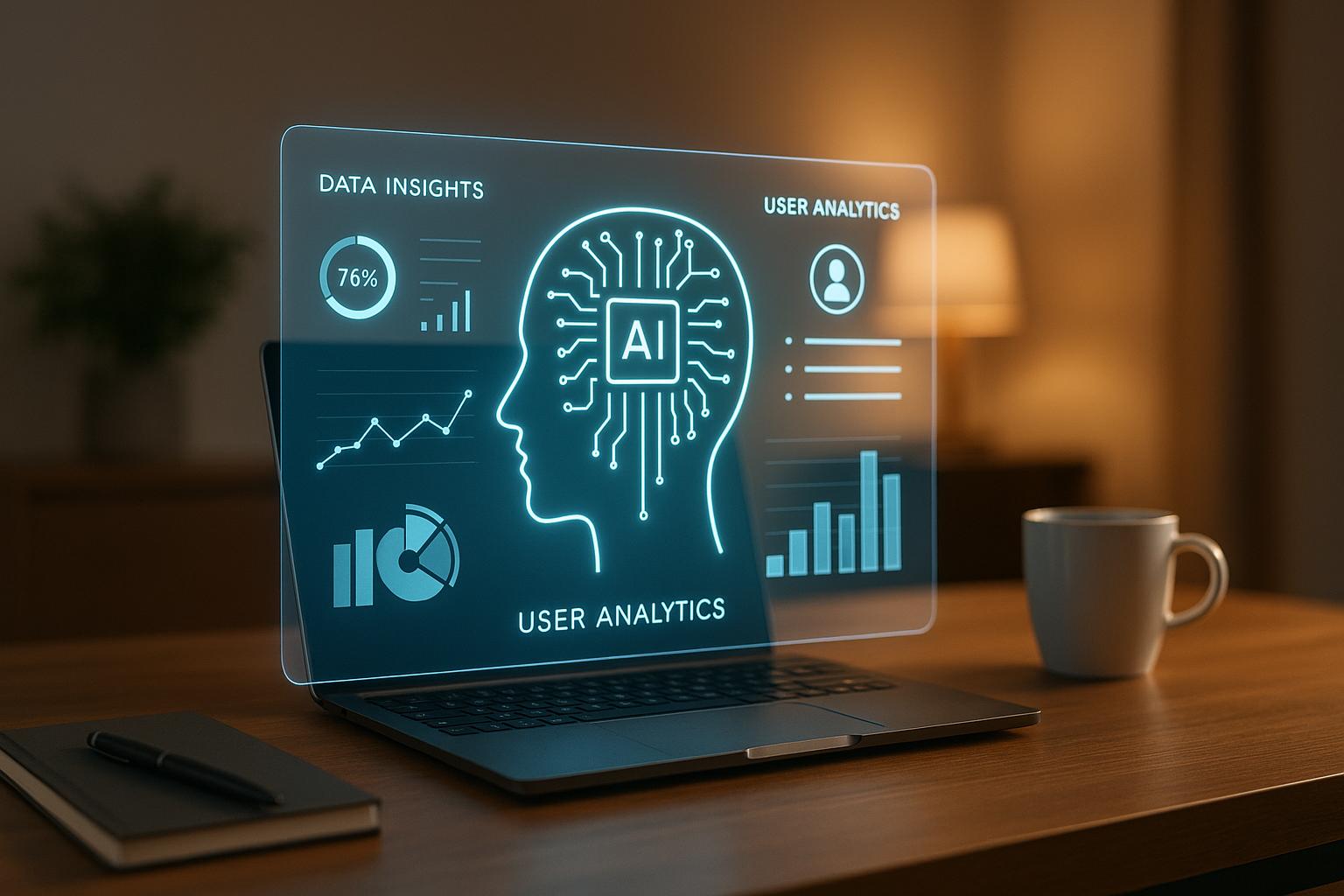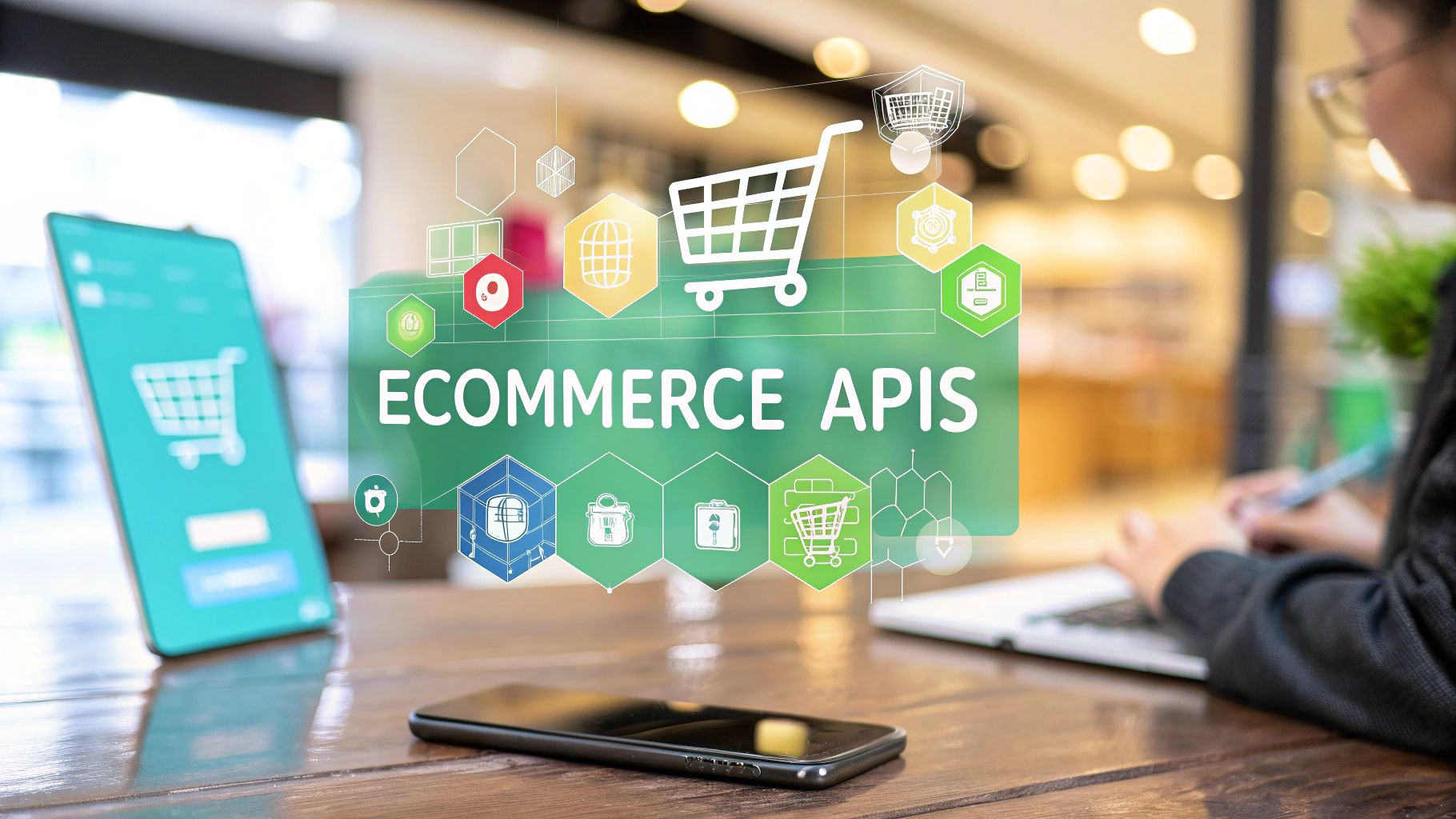AI is transforming Digital Experience Platforms (DXPs) by enabling real-time personalization, automating tasks, and delivering data-driven insights. Businesses using AI in DXPs report increased customer satisfaction, better operational efficiency, and higher ROI. However, challenges like data privacy, technical complexity, and high costs remain key barriers.
Key Takeaways:
- Benefits:
- AI enables real-time personalization, improving user engagement (e.g., 77% of users pay more for tailored experiences).
- Automating processes boosts efficiency, saving time and resources.
- Data-driven insights support better decision-making, with companies like Netflix driving 80% of content views through AI recommendations.
- Challenges:
- Data privacy concerns and compliance issues (e.g., GDPR).
- Implementation difficulties, with 90% of companies struggling to integrate AI into existing systems.
- High upfront costs, though businesses often see a 3.5× ROI.
AI Integration Approaches:
- Built-In AI Features: Tools like Sitecore and Adobe Experience Manager offer pre-integrated AI capabilities for easier adoption.
- Third-Party AI Tools: External APIs enhance functionality but require careful integration.
- Hybrid Models: Combine in-house AI with third-party solutions for flexibility and control.
AI in DXPs is reshaping customer experiences, but success requires careful planning, robust data management, and clear strategies to address risks. Businesses should start small, prioritize high-impact areas, and ensure their teams are ready for AI adoption.
CLIENTS & INDUSTRY - Drupal DXP meets AI: Unlocking the Full Potential of Digital Experiences
Benefits of AI-Driven Personalization in DXPs
AI-driven personalization isn't just a buzzword - it’s a game-changer for enhancing customer engagement, streamlining operations, and improving decision-making. Let’s break down how these benefits translate into meaningful results for businesses.
Real-Time Personalization and Better User Engagement
AI’s ability to process data instantly allows businesses to deliver personalized experiences on the spot. And the numbers back this up: 76% of consumers feel frustrated when interactions aren’t personalized, while 77% are willing to pay more for tailored experiences. Personalized emails? They achieve a 26% higher open rate, and 56% of customers return after a personalized interaction. Expectations are climbing too - 71% of consumers now expect personalized interactions, and 52% look forward to tailored offers.
For example, an e-commerce platform can use AI to analyze a shopper's browsing habits and purchase history in real time. This enables the platform to recommend products that match the customer’s preferences, creating a seamless and intuitive experience. These personalized interactions don’t just boost engagement - they also set the stage for smoother operations, as we’ll see next.
Improved Efficiency Through AI Automation
AI automation is a productivity powerhouse for Digital Experience Platforms (DXPs). By automating repetitive tasks and streamlining workflows, AI helps businesses operate more efficiently. Research shows that companies with highly efficient operations are 2.2 times more likely to outperform their competitors. Meanwhile, McKinsey reports that AI can automate 60% to 70% of the tasks that currently consume employees' time.
The impact is clear in real-world applications. AI tools can simplify onboarding processes, provide instant customer support, and even handle complex tasks like contract reviews or inventory management. These advancements save time, cut costs, and free up employees to focus on higher-value work. But the benefits don’t stop there - AI is also reshaping how businesses make decisions.
Data-Driven Decision Making and Insights
AI’s ability to analyze massive amounts of data is transforming decision-making for businesses. By identifying patterns and trends that might otherwise go unnoticed, AI enables leaders to make more accurate, timely, and effective decisions. This is a big deal when 58% of business leaders admit they rely on instinct rather than data.
AI-powered analytics unlock new opportunities by offering deeper insights into customer behavior. Just look at industry leaders: Amazon uses AI to personalize shopping experiences, Netflix’s recommendation engine drives 80% of its viewed content, and Starbucks leverages loyalty program data to refine store locations and improve customer retention.
Beyond uncovering opportunities, AI also brings accountability and transparency to decision-making by ensuring choices are based on solid data. When combined with human expertise, AI insights enable businesses to act quickly and confidently, making decisions that are both precise and impactful.
Challenges and Risks of AI Integration in DXPs
AI-driven personalization can transform Digital Experience Platforms (DXPs), but implementing these technologies comes with its fair share of challenges. Being aware of these obstacles early on helps businesses prepare and create strategies to tackle potential issues effectively.
Data Privacy and Regulatory Compliance
AI systems handle massive amounts of sensitive data and can infer additional information about individuals - something traditional software doesn’t do. This capability raises serious compliance concerns. For instance, 92% of organizations acknowledge the need for new approaches to manage AI risks, and 69% face legal and intellectual property challenges tied to AI usage.
Real-world examples highlight these risks. In California, a surgical patient discovered her medical photos were included in an AI training dataset, despite giving consent solely for clinical purposes. Similarly, a March 2023 incident involving ChatGPT revealed a data leak where users could view conversation titles from unrelated accounts.
"We're seeing data such as a resume or photograph that we've shared or posted for one purpose being repurposed for training AI systems, often without our knowledge or consent." - Jennifer King, Fellow at the Stanford University Institute for Human-Centered Artificial Intelligence
To mitigate these risks, businesses should take several steps:
- Conduct AI Impact Assessments.
- Design systems with privacy as a foundational principle.
- Implement strict data retention policies.
- Perform regular AI audits.
- Ensure transparency in AI decision-making processes.
Enhanced security measures are particularly crucial in sensitive areas like healthcare, employment, and personal finance. These privacy concerns add to the already complex technical challenges of AI integration.
Implementation Complexity and Skill Gaps
Technical hurdles are another major roadblock. Integrating AI into platforms like Sitecore or Adobe Experience Manager is no small feat. In fact, 74% of companies report difficulties in scaling AI effectively, and over 90% struggle to integrate AI with their existing systems.
Skill shortages compound the issue. Only 10% of workers possess the AI expertise companies need, while 98% of employees express interest in learning about generative AI. Additionally, nearly 40% of core skills are expected to evolve due to the rise of generative AI.
To navigate these challenges, organizations can:
- Upskill their workforce through targeted training programs.
- Partner with AI consultants who bring specialized expertise.
- Use APIs and middleware to connect AI models with legacy systems.
- Start with pilot projects to test feasibility before scaling.
- Foster collaboration across teams to align technology goals with workflows.
- Build relationships with academic institutions to tap into new talent and insights.
While technical and regulatory hurdles are significant, understanding the financial aspects of AI integration is equally important.
Cost and ROI Considerations
Custom AI development can cost anywhere from $20,000 to $500,000, while off-the-shelf solutions range from $99 to $1,500 per month. Breaking down expenses, model complexity accounts for 30–40% of project costs, while data preparation represents 15–25%.
Despite the steep upfront costs, AI investments can pay off significantly. On average, companies see a return of 3.5× their investment, with 5% of businesses reporting returns as high as 8×. Companies like Netflix, H&M, and Bank of America have demonstrated measurable cost savings and increased operational efficiency through AI.
To maximize ROI, businesses should:
- Use pre-built AI models to reduce development costs.
- Focus on efficient data management from the beginning.
- Scale incrementally, starting small and expanding based on results.
- Continuously measure performance in real time to track AI’s value over time.
- Take a portfolio approach to evaluate the combined impact of all AI initiatives.
Effectively addressing these challenges requires thoughtful planning and investment, ensuring AI initiatives not only deliver business value but also manage risks responsibly.
Methods for Adding AI to DXPs
When it comes to integrating AI into Digital Experience Platforms (DXPs), enterprises typically follow one of three main approaches. Each method comes with its own set of benefits and challenges, depending on the organization’s goals, resources, and level of readiness for AI adoption.
Built-In AI Features in Leading Platforms
Many top DXPs come with built-in AI features, making it easier for businesses to implement personalization and automation without requiring extensive custom development. For instance:
- Sitecore includes machine learning tools for content optimization and analyzing visitor behavior.
- Adobe Experience Manager, through its Sensei technology, offers AI-driven content recommendations and automated A/B testing.
These native features integrate smoothly with existing platforms, minimizing the complexity of setup and ongoing maintenance. However, their broad design may not always meet highly specific business needs. They are especially useful for organizations at early AI adoption stages (Levels 1 or 2), where the focus is on learning and leveraging trusted vendor solutions.
If built-in capabilities don’t fully address specific requirements, external tools can provide the additional functionality needed.
Third-Party AI Integrations
Third-party AI tools and APIs can deliver advanced capabilities, such as natural language processing, computer vision, predictive analytics, or models tailored to specific industries. These external solutions allow businesses to expand their DXP’s functionality beyond what’s available natively.
While these tools can significantly enhance a platform’s capabilities, integrating them often requires meticulous planning. Factors like data flow, security, and compatibility need careful attention. According to Gartner, poor data quality is a major challenge, with 85% of AI projects failing due to insufficient data preparation. This highlights the importance of robust data management when using external AI tools.
Some third-party AI services offer pay-per-use pricing, which can be cost-effective for smaller-scale implementations. However, enterprise-level solutions may involve higher, ongoing costs.
For organizations looking to strike a balance, combining in-house and external solutions can offer greater flexibility.
Hybrid Approaches for Maximum Flexibility
A hybrid approach blends in-house AI development with third-party solutions, allowing businesses to maintain control over core capabilities while quickly deploying standard functionalities. This approach offers the best of both worlds - customization where it matters most and efficiency for less critical functions.
Take Uber as an example. The company develops its core routing and pricing algorithms internally but relies on external tools for customer service chatbots, fraud detection, and mapping data. This strategy has led to measurable benefits, including a 40% reduction in total AI costs. Uber was able to roll out core capabilities within 12 months and complete its full AI suite in just 24 months.
Here’s a quick comparison of building, buying, and hybrid approaches:
| Need | Build Advantage | Buy Limitation | Hybrid Option |
|---|---|---|---|
| Proprietary algorithms | ✓ Full control | ✗ Restricted to vendor capabilities | ⚡ Core algorithms in-house, peripherals outsourced |
| Industry-specific models | ✓ Tailored to unique needs | ⚠ Generic solutions may not fit | ⚡ Custom training on vendor platforms |
| Competitive differentiation | ✓ Unique, hard-to-replicate solutions | ✗ Competitors can use the same tools | ⚡ Proprietary data with vendor infrastructure |
| Rapid iteration | ⚠ Slower initial development | ✓ Faster deployment and updates | ⚡ Quick pilots, custom development for proven ideas |
Recent data shows that 35% of enterprises have reached AI maturity Level 3. These organizations have established strong data pipelines, cross-functional AI teams, and predictive analytics in production, making them ideal candidates for a hybrid strategy.
Before adopting a hybrid model, businesses should evaluate their AI maturity, assess internal skills, ensure their data infrastructure is ready, and clearly define their needs. Sensitive data processing can often remain in-house, while less critical functions are outsourced.
Ultimately, the choice of integration method should align with your business goals and strategy. McKinsey research reveals that companies with mature AI pipelines can achieve results up to 80% faster than those relying solely on custom developments.
sbb-itb-91124b2
Future Trends and Recommendations
The evolution of AI is redefining Digital Experience Platforms (DXPs) with trends like hyper-personalization, emotional intelligence, voice analytics, omnichannel integration, agentic AI, and composable experiences. These advancements are setting new benchmarks for businesses aiming to stay competitive.
Emerging Trends in AI for DXPs
Hyper-personalization is transforming customer journeys by using real-time behavioral data and predictive analytics. By 2025, this approach could help retailers boost revenues by up to 40%. In the U.S., where 80% of consumers prefer personalized experiences, this trend is especially impactful.
AI-driven emotional intelligence is enabling platforms to engage with empathy. Through natural language processing and sentiment analysis, these systems can identify and respond to customer emotions. The emotional AI market is projected to reach $91.67 billion by 2025, and platforms leveraging this technology could see customer satisfaction rise by 40–50%.
Voice technology is also on the rise, with voice searches expected to make up 50% of all searches by 2025. This underscores the importance of optimizing content for conversational queries.
Omnichannel AI integration is becoming a necessity. Businesses using omnichannel strategies report a 91% higher year-over-year increase in customer retention rates. This is particularly relevant as 73% of shoppers now interact with multiple channels during their purchasing journey.
The emergence of agentic AI is pushing systems toward greater autonomy, allowing them to make decisions without constant human oversight. However, this shift emphasizes the need for strong governance to keep AI aligned with business objectives.
Lastly, composable experiences are gaining momentum. By adopting modular, API-first frameworks, businesses can create scalable digital ecosystems that adapt quickly to new AI capabilities while maintaining stability.
Practical Steps for AI Integration Success
To successfully integrate AI into DXPs, businesses need a clear and well-structured strategy. Start by auditing and unifying your first-party data. This enables real-time personalization and ensures your data foundation is solid.
Develop transparent AI governance policies to manage data usage and comply with regulations like GDPR. With 94% of businesses acknowledging that mishandling data could drive customers away, maintaining trust is non-negotiable.
Optimize your content for AI-readability and featured snippets. This includes implementing a voice-search strategy that prioritizes conversational keywords, which will become increasingly important as voice interactions grow.
Consider introducing virtual concierge tools to transform physical touchpoints into tailored customer support experiences.
Invest in training your team to maximize the potential of AI-native tools. Setting up internal working groups and providing training on AI applications and prompting techniques can help your organization stay ahead.
Low-code and no-code platforms are another game-changer, empowering non-technical users to customize digital experiences with ease.
By following these steps, businesses can integrate AI effectively while minimizing risks and maximizing value.
How Kogifi Supports AI-Driven Personalization

Kogifi specializes in helping businesses navigate the complexities of AI-driven personalization. With expertise in platforms like Sitecore, Adobe Experience Manager, and SharePoint, they provide services ranging from platform audits to real-time data integration and UX/UI optimization. Their 24/7 support ensures that businesses can deliver seamless, omnichannel customer experiences.
For companies looking to leverage AI, Kogifi offers platform implementation and upgrade services to unlock the potential of built-in tools like Sitecore’s machine learning features or Adobe’s Sensei technology. When native capabilities fall short, they facilitate third-party AI integrations, tailoring solutions to meet specific business needs.
"The future of the DXP market relies on a balance between human control and AI... As brands scale personalized experiences, AI will play a growing role in content creation, optimization, and decision-making. However, expert contextual guidance will remain critical for teaching AI systems how to be effective." - Mo Cherif, VP of AI & Innovation at Sitecore
Conclusion: Weighing the Benefits and Challenges
Integrating AI-driven personalization into Digital Experience Platforms (DXPs) comes with distinct advantages and hurdles. On the plus side, it offers real-time personalization, enhanced efficiency through automation, and data-driven insights. However, challenges like data privacy concerns, implementation complexity, and upfront costs cannot be overlooked.
Organizations also face issues such as technical skill gaps and the need for ongoing system maintenance. To effectively embrace AI, companies must prioritize AI readiness, which ensures resources are allocated wisely and projects gain momentum.
"AI readiness refers to an organization's ability to embrace AI opportunities while managing the risks effectively." - Nexla
A successful transition to AI in DXPs starts with a detailed readiness assessment. This means evaluating key areas like technology infrastructure, data quality, workforce capabilities, and governance frameworks before scaling up. Some critical steps include setting clear goals, ensuring high-quality data, securing executive buy-in, and fostering collaboration across teams. Additionally, implementing strong risk management processes to identify and address potential issues early is vital.
For companies exploring AI adoption, starting small with pilot projects can be a smart strategy. These projects should focus on areas that promise clear returns on investment while helping teams build the necessary skills and confidence for broader implementation. Establishing a solid data foundation and targeting high-impact areas can make scaling AI much smoother.
The key to success lies in balancing human expertise with AI capabilities. By investing in thoughtful planning, robust governance, and phased implementation, organizations can harness AI's transformative potential while minimizing risks.
If you're ready to take the next step, assess your AI readiness by focusing on data quality, technical infrastructure, and team capabilities. For expert guidance, Kogifi can help you navigate these challenges and create a future-ready digital environment.
FAQs
How can businesses protect user data and stay compliant when using AI in Digital Experience Platforms?
Protecting User Data in AI-Driven Digital Experience Platforms
When incorporating AI into Digital Experience Platforms (DXPs), safeguarding user data isn't just a technical requirement - it's a responsibility. To achieve this, businesses should follow privacy by design principles and establish strong data governance practices.
Start by keeping a detailed and accurate inventory of all data. Use encryption to secure it, and apply methods like pseudonymization and anonymization to shield sensitive information effectively. These steps go a long way in minimizing risks.
Compliance with laws such as GDPR or HIPAA is non-negotiable. Regular audits, clear and transparent privacy policies, and user-friendly consent mechanisms not only ensure adherence to these regulations but also help earn user trust.
Finally, building a culture of accountability within your organization is key. This means ensuring your team understands the ethical and responsible use of AI tools, reinforcing the idea that protecting user data is everyone's job.
How can companies address the technical challenges and skill gaps when implementing AI in digital experience platforms (DXPs)?
Companies can address the technical challenges and skill gaps in implementing AI for DXPs by adopting a thoughtful approach. One key step is to invest in employee training programs that focus on building in-house expertise. Collaborating with educational institutions or offering tailored AI-focused courses can also play a big role in closing knowledge gaps.
Another helpful tactic is utilizing user-friendly, no-code AI tools. These tools enable teams to work with AI solutions without needing advanced technical skills. On top of that, establishing a well-organized and properly managed data environment ensures that AI-generated insights are both useful and easy to integrate into everyday business operations. By following these steps, organizations can simplify AI adoption and make it more practical for everyone involved.
What are the costs and potential ROI of integrating AI into digital experience platforms, and how can businesses make the most of their investment?
Integrating AI into Digital Experience Platforms (DXPs)
Bringing AI into digital experience platforms (DXPs) comes with costs - development, implementation, and ongoing maintenance - all of which depend on the project's size and complexity. While the initial investment might feel hefty, the potential payoff can be well worth it. AI-driven personalization and automation have the power to increase engagement, elevate customer experiences, and ultimately drive revenue growth.
To see the best return on investment (ROI), businesses should zero in on high-impact opportunities like personalized customer journeys or predictive analytics. Start small by targeting areas where AI can quickly make a difference, such as automating repetitive tasks or refining marketing campaigns to better reach specific audiences. By using strong data analytics tools and regularly tracking results, companies can ensure their AI efforts stay aligned with their goals and continue delivering long-term value.








































